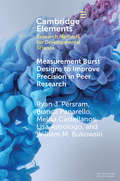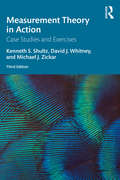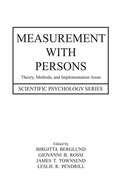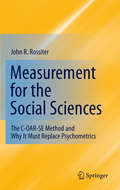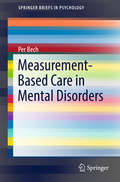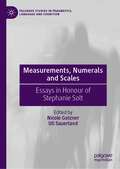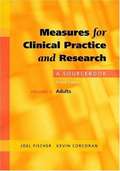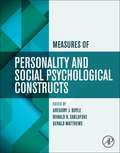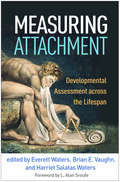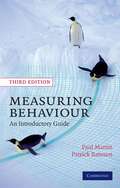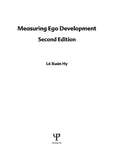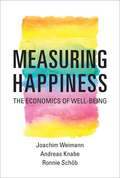- Table View
- List View
Measurement Burst Designs to Improve Precision in Peer Research (Elements in Research Methods for Developmental Science)
by William M. Bukowski Ryan J. Persram Bianca Panarello Melisa Castellanos Lisa AstrologoMeasurement burst designs, in which assessments of a set of constructs are made at two or more times in quick succession (e.g., within days), can be used as a novel method to improve the stability of basic measures typically used in longitudinal peer research. In this Element, we hypothesized that the stabilities for adolescent-reported peer acceptance, anxiety, and self-concept would be stronger when using the measurement burst approach versus the single time observation. Participants included youth between 10 and 13 years old who completed (a) sociometric assessments of acceptance, and measures of (b) social and test anxiety, and (c) self-concept across three times with two assessments made at each burst. Findings broadly showed that the stabilities were significantly stronger with the measurement burst when compared to the single time assessment, supporting our main hypothesis. We discuss the utility of the measurement burst in a broader context and considerations for researchers.
Measurement Theory in Action: Case Studies and Exercises
by David J. Whitney Kenneth S Shultz Michael J ZickarMeasurement Theory in Action, Third Edition, helps readers apply testing and measurement theories and features 22 self-contained modules which instructors can match to their courses. Each module features an overview of a measurement issue and a step-by-step application of that theory. Best Practices provide recommendations for ensuring the appropriate application of the theory. Practical Questions help students assess their understanding of the topic. Students can apply the material using real data in the Exercises, some of which require no computer access, while others involve the use of statistical software to solve the problem. Case Studies in each module depict typical dilemmas faced when applying measurement theory followed by Questions to Ponder to encourage critical examination of the issues noted in the cases. The book’s website houses the data sets, additional exercises, PowerPoints, and more. Other features include suggested readings to further one’s understanding of the topics, a glossary, and a comprehensive exercise in Appendix A that incorporates many of the steps in the development of a measure of typical performance. Updated throughout to reflect recent changes in the field, the new edition also features: Recent changes in understanding measurement, with over 50 new and updated references Explanations of why each chapter, article, or book in each module’s Further Readings section is recommended Instructors will find suggested answers to the book’s questions and exercises; detailed solutions to the exercises; test bank with 10 multiple choice and 5 short answer questions for each module; and PowerPoint slides. Students and instructors can access SPSS data sets; additional exercises; the glossary; and additional information helpful in understanding psychometric concepts. It is ideal as a text for any psychometrics or testing and measurement course taught in psychology, education, marketing, and management. It is also an invaluable reference for professional researchers in need of a quick refresher on applying measurement theory.
Measurement Theory in Action: Case Studies and Exercises, Second Edition
by Kenneth S. Shultz Michael J. Zickar David J. WhitneyThis book helps readers apply testing and measurement theories. Featuring 22 self-standing modules, instructors can pick and choose the ones that are most appropriate for their course. Each module features an overview of a measurement issue and a step-by-step application of that theory. Best practices provide recommendations for ensuring the appropriate application of the theory. Practical questions help students assess their understanding of the topic while the examples allow them to apply the material using real data. Two cases in each module depict typical dilemmas faced when applying measurement theory followed by Questions to Ponder to encourage critical examination of the issues noted in the cases. Each module contains exercises some of which require no computer access while others involve the use of SPSS to solve the problem. The book's website houses the accompanying data sets and more. The book also features suggested readings, a glossary of the key terms, and a continuing exercise that incorporates many of the steps in the development of a measure of typical performance. Updated throughout to reflect recent changes in the field, the new edition also features: --A new co-author, Michael Zickar, who updated the advanced topics and added the new module on generalizability theory (Module 22). -Expanded coverage of reliability (Modules 5 & 6) and exploratory and confirmatory factor analysis (Modules 18 & 19) to help readers interpret results presented in journal articles. -Expanded Web Resources, Instructors will now find: suggested answers to the book's questions and exercises; detailed worked solutions to the exercises; and PowerPoint slides. Students and instructors can access the SPSS data sets; additional exercises; the glossary; and website references that are helpful in understanding psychometric concepts. Part 1 provides an introduction to measurement theory and specs for scaling and testing and a review of statistics. Part 2 then progresses through practical issues related to text reliability, validation, meta-analysis and bias. Part 3 reviews practical issues related to text construction such as the development of measures of maximal performance, CTT item analysis, test scoring, developing measures of typical performance, and issues related to response styles and guessing. The book concludes with advanced topics such as multiple regression, exploratory and confirmatory factor analysis, item response theory (IRT), IRT applications including computer adaptive testing and differential item functioning, and generalizability theory. Ideal as a text for any psychometrics, testing and measurement, or multivariate statistics course taught in psychology, education, marketing and management, professional researchers in need of a quick refresher on applying measurement theory will also find this an invaluable reference.
Measurement With Persons: Theory, Methods, and Implementation Areas (Scientific Psychology Series)
by Birgitta Berglund Giovanni B. Rossi James T. Townsend Leslie R. PendrillMeasurements with persons are those in which human perception and interpretation are used for measuring complex, holistic quantities and qualities, which are perceived by the human brain and mind. Providing means for reproducible measurement of parameters such as pleasure and pain has important implications in evaluating all kind of products, services, and conditions. This book inaugurates a new era for this subject: a multi- and inter-disciplinary volume in which world-renowned scientists from the psychological, physical, biological, and social sciences reach a common understanding of measurement theory and methods. In the first section, generic theoretical and methodological issues are treated, including the conceptual basis of measurement in the various fields involved; the development of formal, representational, and probabilistic theories; the approach to experimentation; and the theories, models, and methods for multidimensional problems. In the second section, several implementation areas are presented, including sound, visual, skin, and odor perception, functional brain imagining, body language and emotions, and, finally, the use of measurements in decision making Measurement with Persons will appeal to a wide audience across a range of sciences, including general psychology and psychophysics, measurement theory, metrology and instrumentation, neurophysiology, engineering, biology, and chemistry.
Measurement across the Sciences: Developing a Shared Concept System for Measurement (Springer Series in Measurement Science and Technology)
by Mark Wilson Luca Mari Andrew MaulThis book proposes a conceptual framework for understanding measurement across a broad range of scientific fields and areas of application, such as physics, engineering, education, and psychology. The authors, who themselves span these disciplines, argue that the justification of the public trust attributed to measurement results can in principle apply identically to both physical and psychosocial properties. They further argue that the lack of a common conceptualization of measurement hampers interdisciplinary communication and limits the ability to share knowledge. They advance their views by first surveying the conceptual history of the philosophy of measurement and arguing that classical, operationalist and representational perspectives on measurement each make important contributions but also each have important shortcomings. A synthesis is then offered as the foundation for a new conceptual framework. The authors describe how the framework, which operates as a shared concept system, supports understanding measurement’s work in different domains, using examples in the physical and human sciences. They consider connections and consequences with respect to causality, objectivity, and intersubjectivity, among other topics, and how measurement science concepts and issues are construed across these disciplines and settings. They also address contemporary issues and controversies within measurement in the light of the framework, including operationalism, definitional uncertainty, and the relations between measurement and computation. The book concludes with a justification for the basic claim that measurement is an empirical and informational process that produces explicitly justifiable information. Researchers and academics across a wide range of disciplines including biological, physical, social and behavioral scientists, as well as specialists in measurement and philosophy will appreciate the work’s fresh and provocative approach to the field at a time when sound measurements of complex scientific systems are increasingly essential to solving critical global problems.
Measurement and Representation of Sensations (Scientific Psychology Series)
by Hans Colonius Ehtibar N. DzhafarovMeasurement and Representation of Sensations offers a glimpse into the most sophisticated current mathematical approaches to psychophysical problems. In this book, editors Hans Colonius and Ehtibar N. Dzhafarov, top scholars in the field, present a broad spectrum of innovative approaches and techniques to classical problems in psychophysics at different levels of stimulus complexity. The chapters emphasize rigorous mathematical constructions to define psychophysical concepts and relate them to observable phenomena. The techniques presented, both deterministic and probabilistic, are all original and recent. Subjects addressed throughout the six chapters of this volume include:*computing subjective distances from discriminability;*a new psychophysical theory of intensity judgments;*computing subjective distances from two discriminability functions;*an alternative to the model-building approach based on observable probabilities; and*possible forms of perceptual separability developed within a generalization of General Recognition Theory. Measurement and Representation of Sensations is a valuable text for both behavioral scientists and applied mathematicians.
Measurement and Statistics for Teachers
by Malcolm L. Van BlerkomMeasurement and Statistics for Teachers deftly combines descriptive statistics and measurement in the classroom into a student-friendly, practical volume. Based on a course taught by the author for the past 25 years, this book offers to undergraduate education students a clear account of the basic issues in measurement and details best practices for administering performance assessments, interpreting test scores, and evaluating student writing. This second edition includes updated pedagogical features, timely discussions of student assessment, state standards (including NCLB), and an expanded focus that incorporates the needs of Early Childhood, Elementary, and Secondary teachers.
Measurement for the Social Sciences
by John R. RossiterThis book proposes a revolutionary new theory of construct measurement - called C-OAR-SE - for the social sciences. The acronym is derived from the following key elements: construct definition; object representation; attribute classification; rater entity identification; selection of item type; enumeration and scoring. The new theory is applicable to the design of measures of constructs in: * Management * Marketing * Information Systems * Organizational Behavior * Psychology * Sociology C-OAR-SE is a rationally rather than empirically-based theory and procedure. It can be used for designing measures of the most complex and also the most basic constructs that we use in social science research. C-OAR-SE is a radical alternative to the traditional empirically-based psychometric approach, and a considerable amount of the book's content is devoted to demonstrating why the psychometric approach does not produce valid measures. The book argues that the psychometric approach has resulted in many misleading findings in the social sciences and has led to erroneous acceptance - or rejection - of many of our main theories and hypotheses, and that the C-OAR-SE approach to measurement would correct this massive problem. The main purpose of this book is to introduce and explain C-OAR-SE construct measurement theory in a way that will be understood by all social science researchers and that can be applied to designing new, more valid measures. Featuring numerous examples, practical applications, end-of-chapter questions, and appendices, the book will serve as an essential resource for students and professional researcher alike.
Measurement in Social Psychology (Frontiers of Social Psychology)
by Hart Blanton LaCroix Jessica M. Webster Gregory D.Although best known for experimental methods, social psychology also has a strong tradition of measurement. This volume seeks to highlight this tradition by introducing readers to measurement strategies that help drive social psychological research and theory development. The books opens with an analysis of the measurement technique that dominates most of the social sciences, self-report. Chapter 1 presents a conceptual framework for interpreting the data generated from self-report, which it uses to provide practical advice on writing strong and structured self-report items. From there, attention is drawn to the many other innovative measurement and data-collection techniques that have helped expand the range of theories social psychologists test. Chapters 2 through 6 introduce techniques designed to measure the internal psychological states of individual respondents, with strategies that can stand alone or complement anything obtained via self-report. Included are chapters on implicit, elicitation, and diary approaches to collecting response data from participants, as well as neurological and psychobiological approaches to inferring underlying mechanisms. The remaining chapters introduce creative data-collection techniques, focusing particular attention on the rich forms of data humans often leave behind. Included are chapters on textual analysis, archival analysis, geocoding, and social media harvesting. The many methods covered in this book complement one another, such that the full volume provides researchers with a powerful toolset to help them better explore what is "social" about human behavior.
Measurement of Executive Function in Early Childhood: A Special Issue of Developmental Neuropsychology (500 Tips)
by Philip David Zelazo Mark T. Greenberg Clancy BlairDuring the past decade, a rising interest has emerged in aspects of the broad construct of executive function (EF) in childhood. This has transpired as research has discovered that the development of EF is particularly rapid during early childhood, and that the healthy development of EF appears to play a key role in children’s developing social competence and academic and social readiness to attend school. The articles presented in this special issue help advance our understanding of the development of EF, as well as the challenges researchers face when attempting to characterize an aspect of cognition in very young children. Ultimately, this special issue illuminates the many ways in which children come to exhibit age-appropriate levels of social and cognitive competence.
Measurement, Design, and Analysis: An Integrated Approach (Psychology Press And Routledge Classic Editions Ser.)
by Elazar J. Pedhazur Liora Pedhazur SchmelkinIn textbooks and courses in statistics, substantive and measurement issues are rarely, if at all, considered. Similarly, textbooks and courses in measurement virtually ignore design and analytic questions, and research design textbooks and courses pay little attention to analytic and measurement issues. This fragmentary approach fosters a lack of appreciation of the interrelations and interdependencies among the various aspects of the research endeavor. Pedhazur and Schmelkin's goal is to help readers become proficient in these aspects of research and their interrelationships, and to use that information in a more integrated manner. The authors offer extensive commentaries on inputs and outputs of computer programs in the context of the topics presented. Both the organization of the book and the style of presentation allow for much flexibility in choice, sequence, and degree of sophistication with which topics are dealt.
Measurement, Mathematics and New Quantification Theory (Behaviormetrics: Quantitative Approaches to Human Behavior #16)
by Shizuhiko NishisatoThe purpose of this book is to thoroughly prepare diverse areas of researchers in quantification theory. As is well known, quantification theory has attracted the attention of a countless number of researchers, some mathematically oriented and others not, but all of them are experts in their own disciplines. Quantifying non-quantitative (qualitative) data requires a variety of mathematical and statistical strategies, some of which are quite complicated. Unlike many books on quantification theory, the current book places more emphasis on preliminary requisites of mathematical tools than on details of quantification theory. As such, the book is primarily intended for readers whose specialty is outside mathematical sciences. The book was designed to offer non-mathematicians a variety of mathematical tools used in quantification theory in simple terms. Once all the preliminaries are fully discussed, quantification theory is then introduced in the last section as a simple application of those mathematical procedures fully discussed so far. The book opens up further frontiers of quantification theory as simple applications of basic mathematics.
Measurement, Statistics, and Research Design in Physical Education and Exercise Science: A Special Issue of Measurement in Physical Education and Exercise Science
by Terry M. WoodThis inaugural issue is devoted to exploring measurement, research design, and statistics issues in six subdisciplines of exercise and sport science. Originally presented at the Eighth Measurement and Evaluation Symposium, all papers in this issue reflect the work of many renowned measurement specialists and content experts in their respective fields. The articles discuss the following topics: * standards of assessment quality for physical educators and the problem of providing adequate assessment without adequate resources; * the importance of properly conceptualizing and defining appropriate research questions as the "source and solution" for measurement and design issues in reference to motor learning/control and sport and exercise psychology; * the study of individuals -- single-subject and other small-sample designs -- in contrast to the more traditional study of groups; and * the importance of computing and reporting statistical power in research.
Measurement-Based Care in Mental Disorders
by Per BechThis innovative monograph introduces a measurement-based framework for effective treatment of patients with mood disorders, personality disorders, and schizophrenia. Rooted firmly in principles of pharmacotherapy and clinical psychometrics, the book's signature diagram balances rating scale results and patient self-reported progress along three angles: therapeutic effects, adverse effects, and quality of life. The author's choices of measures are brief, valid, widely used, and easy for clinicians to administer and patients to understand. But rather than being a mechanistic or an impersonal formula, this system is shown as a science-based means of fostering constructive collaboration between patient and therapist, leading to greater patient well-being. Included in the coverage: #65533; Negative mental health: the ordinary symptom-orientated mental disorders. #65533; The basic diagram of personality dimensions. #65533; Self-reported symptom scales within the basic diagram. #65533; Clinician-administered symptom scales within the basic diagram. #65533; The pharmacopsychometric triangle in measurement-based care. #65533; Diagnostic rating scales. #65533; A practical outcome evaluation plan. Offering a medical level of precision to mental health, Measurement-Based Care in Mental Disorders should interest health care providers at all levels, particularly physicians and staff in primary care settings, and in psychiatric in- and outpatient clinics, including psychiatrists, psychologists, nurses, and social workers.
Measurements, Numerals and Scales: Essays in Honour of Stephanie Solt (Palgrave Studies in Pragmatics, Language and Cognition)
by Nicole Gotzner Uli SauerlandThis book brings together chapters on the semantics and pragmatics of measurement, scales, and numerical expressions. The chapters highlight recent developments in measurement theory, the meaning of numerical expressions and the relation between measurement scales and entailment scales. The authors provide explorations in formal and experimental semantics and pragmatics, as well as at the interfaces of this field with others including philosophy of language and sociolinguistics. This book will be of interest to students and scholars in these areas, as well as psychology, psycholinguistics and artificial intelligence.
Measures For Clinical Practice And Research: Volume 2 Adults
by Kevin Corcoran Joel FischerThe fourth edition of this essential resource has dozens of new scales as well as updated information for existing instruments, expanding and cementing its utility for members of all the helping professions, including psychology, social work, psychiatry, counseling, nursing, and medicine. Each instrument is reproduced in its entirety and critiqued by the editors, who provide guidance on how to select and score them. This volume focuses on scales for use with adults; its companion provides a range for couples, families, and children. Alone or as a set, these classic compendiums are powerful tools that clinicians and researchers alike will find an invaluable addition to - or update of - their libraries. Giving clinicians the scales they need to measure their clients' problems and monitor their outcomes, these all-in-one sourcebooks bring effective, accountable practice within reach for today's busy professionals.
Measures for Clinical Practice and Research, Volume 1: Couples, Families, and Children (Fifth Edition)
by Kevin Corcoran Joel FischerOne of the key challenges of all types of practice and research is finding a way to measure the problem. This seminal 2-volume book contains hundreds of the most useful measurement tools for use in clinical practice and in research. All measures are critiqued by the editors, who provide guidance on how to select and score them and the actual measures are wholly reproduced. This first volume, focusing on measures for use with couples, families, and children, includes an introduction to the basic priniciples of measurement, an overview of different types of measures, and an overview of the Rapid Assessment Inventories included herein. Volume I also contains descriptions and reviews of each instrument, as well as information on how they were selected and how to administer and score them. This book is designed as the definitive reference volume on assessment measures for both practice and research in clinical mental health. This fifth edition of Corcoran and Fischer's Measures for Clinical Practice and Research is updated with a new preface, new scales, and updated information for existing instruments, expanding and cementing its utility for members of all the helping professions, including psychology, social work, psychiatry, counseling, nursing, and medicine. Alone or as a set, these classic compendiums are powerful tools that clinicians and researchers alike will find an invaluable addition to - or update of - their libraries.
Measures of Personality and Social Psychological Constructs
by Gerald Matthews Gregory Boyle Donald Saklofske<p>Measures of Personality and Social Psychological Constructs assists researchers and practitioners by identifying and reviewing the best scales/measures for a variety of constructs. Each chapter discusses test validity, reliability, and utility. Authors have focused on the most often used and cited scales/measures, with a particular emphasis on those published in recent years. Each scale is identified and described, the sample on which it was developed is summarized, and reliability and validity data are presented, followed by presentation of the scale, in full or in part, where such permission has been obtained. <p>Measures fall into five broad groups. The emotional disposition section reviews measures of general affective tendencies, and/or cognitive dispositions closely linked to emotion. These measures include hope and optimism, anger and hostility, life satisfaction, self-esteem, confidence, and affect dimensions. Emotion regulation scales go beyond general dispositions to measure factors that may contribute to understanding and managing emotions. These measures include alexithymia, empathy, resiliency, coping, sensation seeking, and ability and trait emotional intelligence. The interpersonal styles section introduces some traditional social-psychological themes in the context of personality assessment. These measures include adult attachment, concerns with public image and social evaluation, and forgiveness. The vices and virtues section reflects adherence to moral standards as an individual characteristic shaped by sociocultural influences and personality. These measures include values and moral personality, religiosity, dark personalities (Machiavellianism,narcissism, and subclinical psychopathy), and perfectionism. The sociocultural interaction and conflict section addresses relationships between different groups and associated attitudes. These measures include cross-cultural values, personality and beliefs, intergroup contact, stereotyping and prejudice, attitudes towards sexual orientation, and personality across cultures.</p>
Measures of Positive Psychology
by Kamlesh Singh Mohita Junnarkar Jasleen KaurThe book contributes to the vast field of research in psychometrics as well as to the growing field of positive psychology. It analyses the development and validation of several constructs of positive psychology like resilience, flow, mindfulness, spirituality, and intrapersonal and interpersonal strengths. The chapters discuss the test construction process and develop scales for constructs that are validated on the Indian population. In most Indian behavioral research, psychological tests from the West are employed without assessing psychometric properties in India. However, establishing validation of psychological tests in a new culture is necessary in order to claim results based on these tests. Hence, this book bridges this gap in positive psychology and its allied fields and develops and standardizes these scales for the Indian population. The new constructed and validated scales have undergone rigorous statistical screening. Psychologists, psychiatrists, and social workers interested in studying well-being in India and in understanding how to create psychometric scales for non-Western populations will find the book useful for their research.
Measuring Advertising Effectiveness
by William D. WellsThis volume includes edited and revised versions of the papers delivered and discussed at the recent Advertising and Consumer Psychology Conference. Following the theme of the conference -- "Measuring Advertising Effectiveness" -- the book blends academic psychology, marketing theory, survey methodology, and practical experience, while simultaneously addressing the problems and limitations of advertising. Acknowledging that advertisements are subtle, diverse, complex phenomena that require detailed investigation, this compilation explores the multidimensional nature of advertising's diverse effects from both academic and applied perspectives. Updates on theories and methods -- along with expert commentaries -- help to make this a valuable collection that will be of interest to advertising and marketing specialists and communications experts alike.
Measuring Attachment: Developmental Assessment across the Lifespan
by Everett Waters, Brian E. Vaughn and Harriet Salatas WatersThis volume provides an in-depth examination of traditional and emerging measures of attachment behavior and representations from infancy to adulthood. Leading authorities share their expertise on the Strange Situation, the Attachment Q-set, Ainsworth's Maternal Sensitivity Scales, the Adult Attachment Interview, the Attachment Script Assessments, and the Adult Attachment Projective Picture System, as well as analogue and experimental methods. The book clarifies the conceptual and empirical underpinnings of the various measures and shows how they fit into a coherent developmental framework. Offering detailed discussions of key constructs such as attachment security, the secure base phenomenon, disorganization, and narrative structure, this is a valuable resource for both researchers and practitioners who use attachment assessments in their work.
Measuring Behaviour: An Introductory Guide
by Paul Martin Patrick BatesonMeasuring Behaviour is a guide to the principles and methods of quantitative studies of behaviour, with an emphasis on techniques of direct observation, recording and analysis. In this new edition, all sections have been updated and revised, some have been expanded and others introduced for the first time. Aimed primarily at undergraduate and graduate students in biology and psychology who are about to embark upon behavioural research projects, this book provides a concise review of methodology that will also be of interest to scientists of all disciplines in which behaviour is measured. Written with brevity and clarity, it is intended, above all, as a practical guide book.
Measuring Couples and Family Dynamics in India: Cultural Adaptations and Validations
by D. Barani Kanth J. Indumathy S. Kadhiravan G. Nagasubramaniyan P. Padma Sri LekhaThis book provides a cross-cultural validation for 18 important questionnaires widely used in family research in India. It addresses the issue of cross-cultural validity by presenting analytical procedures and evidences for the validity of these scales in the Indian cultural context. Additionally, it offers valuable methods and procedures involved in the translation, adaptation and cross-cultural validation of scales in family research. The book also discusses essential nuances in data analysis, including Confirmatory Factor Analysis (CFA), Measurement Invariance (MI), and constructs validity while developing and validating scales used in social science research. It is an ideal companion for any researcher or practitioner looking for scales validated in the Indian cultural context in family psychology. It is also suitable for students interested in learning the practical aspects of psychometric methods and the validation of scales.
Measuring Ego Development: The Washington University Sentence Completion Test
by Le Xuan Hy Jane LoevingerThe topic of ego development developed when psychoanalysis did not fulfill all the initial hopes during its early period of prominence. Clinicians--psychiatrists, psychologists, social workers, and counselors--realized that they needed to know more than their patients' or clients' psychopathology or normalcy and their psychosexual behavior and drives. The method for scoring sentence completions presented in this manual was originally developed for a study of women and adolescent girls. By the time it was first published in 1970, however, the method had already come into use in studies of men and boys. Since then, it has been used with widely varying samples, and the test has been translated into several other languages. This wide adoption testifies to the need for such a test. The present version of the manual incorporates three major improvements: * it is based on data from, and is intended for use with, both males and females, * its format is easier to use, and * the examples cited reflect current public attitudes. The format of the scoring manual for the Sentence Completion Test (SCT) is radically changed from the original, making it easier to find the correct rating for a response. The rating scale itself is kept simple and the basic concept of ego development is the same. A tutorial is included to assist in calculating the Total Protocol Ratings (TPRs). ALTERNATIVE BLURB!!! The Washington University Sentence Completion Test, which was developed by Jane Loevinger, is a free-response, semi-projective instrument for the assessment of ego development. The first manual for administering and scoring the test was published in 1970. In addition to its widespread use in the United States, it has also been adopted for use in Canada, the United Kingdom, France, Germany, Italy, the Netherlands, Japan, India, and South Africa. The WUSCT has been used for research in the fields of adolescent personality development, moral development, infancy and parenting, family and gender studies, multiculturalism, religion, psychopathology and psychotherapy, vocational studies, and social and organizational psychology. It is most frequently used by researchers and practitioners in psychology, counseling, social work, and education. This book represents a revised edition of the WUSCT scoring manual, including all items in the 1981 forms, which were revised for use with both men and women. The content reflects current social attitudes, which have changed on some topics since the publication of the original 1970 manual. Although there have been minor changes in terminology, the conception of ego development is unchanged, and the stages of the construct are essentially the same. The format of the scoring manual, however, has been radically changed for ease of use in rating responses. (The rating scale itself, which is the same for all items, is kept simple.) A tutorial is included to assist in calculating the Total Protocol Ratings.
Measuring Happiness
by Ronnie Schöb Joachim Weimann Andreas KnabeCan money buy happiness? Is income a reliable measure for life satisfaction? In the West after World War II, happiness seemed inextricably connected to prosperity. Beginning in the 1960s, however, other values began to gain ground: peace, political participation, civil rights, environmentalism. "Happiness economics" -- a somewhat incongruous-sounding branch of what has been called "the dismal science" -- has taken up the puzzle of what makes people happy, conducting elaborate surveys in which people are asked to quantify their satisfaction with "life in general." In this book, three economists explore the happiness-prosperity connection, investigating how economists measure life satisfaction and well-being.The authors examine the evolution of happiness research, considering the famous "Easterlin Paradox," which found that people's average life satisfaction didn't seem to depend on their income. But they question whether happiness research can measure what needs to be measured. They argue that we should not assess people's well-being on a "happiness scale," because that necessarily obscures true social progress. Instead, rising income should be understood as increasing opportunities and alleviating scarcity. Economic growth helps societies to sustain freedom and to finance social welfare programs. In this respect, high income may not buy happiness with life in general, but it gives individuals the opportunity to be healthier, better educated, better clothed, and better fed, to live longer, and to live well.
